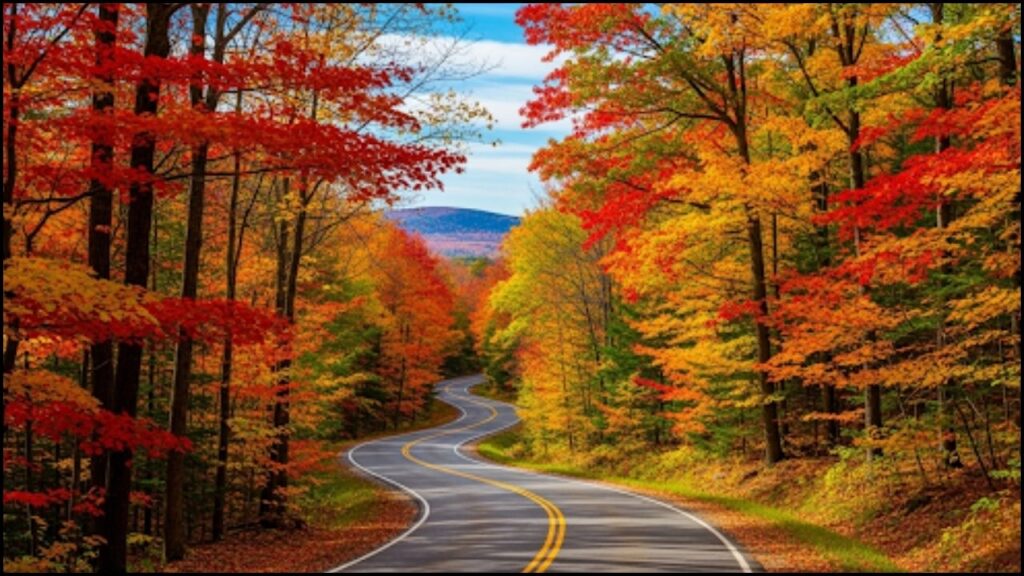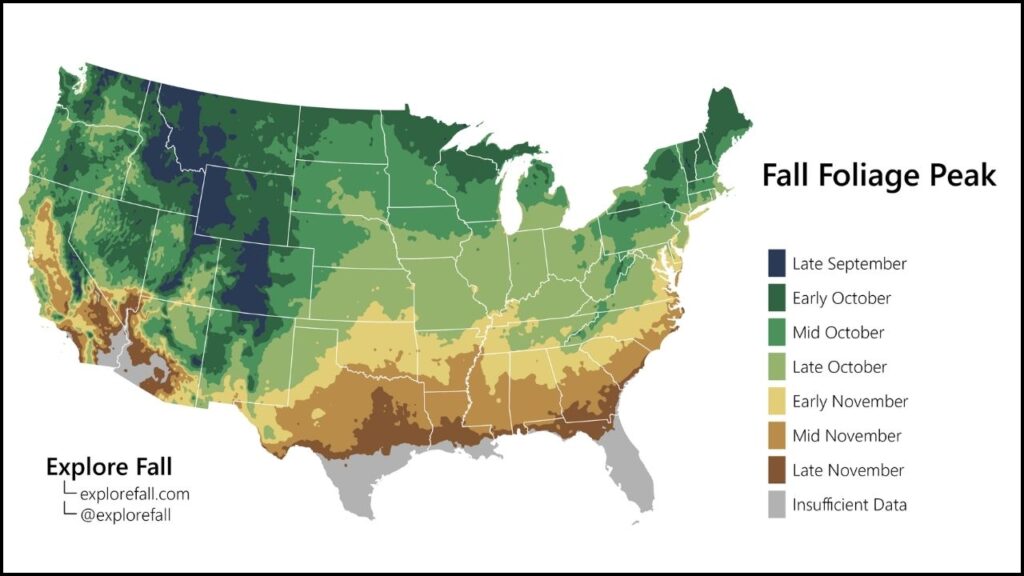The annual spectacle of autumn is approaching, with meteorologists and forestry experts providing forecasts for when fall foliage will reach peak color across North America. This year’s predictions suggest a complex and varied season, shaped by a mix of recent weather patterns, including periods of heavy rain and localized drought. While the consistent shortening of daylight hours remains the primary trigger for the change, the intensity and timing of this year’s displays will be highly dependent on regional conditions.

Key Insights: Fall 2025 Foliage Forecast
| Key Fact | Detail/Statistic |
| Primary Driver | The shortening of daylight hours signals trees to stop producing chlorophyll, revealing underlying pigments. |
| New England Forecast | Peak color may emerge slightly earlier than average due to an emerging late-summer drought, potentially shortening the viewing window. |
| Western U.S. Outlook | Drought conditions in the Rocky Mountains and Pacific Northwest are expected to result in a shorter and less vibrant season. |
| Midwest & Southeast | A wet summer in many areas points toward a strong, vibrant season, provided September brings a pattern of sunny days and cool, crisp nights. |
The Science Behind the Spectacle
The process of leaves changing color is a natural, biological response to environmental cues, primarily the decrease in daylight hours after the summer solstice. This triggers a cascade of chemical changes within the leaves. The green pigment, chlorophyll, which is essential for photosynthesis, breaks down as the tree begins to prepare for its dormant winter state.
According to the U.S. Forest Service, this breakdown allows other pigments that were present throughout the growing season to become visible. Carotenoids, which are responsible for yellows and oranges, are always in the leaves but are masked by the abundant green of chlorophyll. The brilliant reds and purples, however, are created by a different pigment called anthocyanin. Unlike carotenoids, anthocyanins are produced in the autumn in response to a combination of bright sunlight and cool, but not freezing, nighttime temperatures.
“The best conditions for vibrant fall foliage are a warm, wet spring followed by a summer with adequate moisture, and then an autumn with sunny days and cool nights,” said Dr. Anya Sharma, a senior fellow at the Brookings Institution specializing in climate ecology. “The sunny days create an excess of sugars in the leaves, which, when trapped by cool nights, fuels the production of those stunning red and purple hues.”
Regional Forecasts for 2025
Predictions for the 2025 fall foliage season vary significantly by region, as local weather conditions play a critical role in the timing and brilliance of the display.
New England & The Northeast
A key destination for “leaf peepers,” the forecast for New England is a mix of promising and concerning signs. Following a wet spring that helped replenish water reserves after a previous drought, the region has experienced hot and dry conditions in late summer. This emerging drought has led some experts to predict an early start to the season.
“We may see fall colors emerge slightly early this year,” noted Jim Salge, a foliage expert for Yankee Magazine. He added that while some drought can intensify colors, it also has the potential to shorten the duration of the show, as stressed trees may drop their leaves more quickly. Historically, northern New England states like Vermont and New Hampshire reach peak color in early to mid-October, with southern areas following later in the month. This year, visitors may need to plan their trips a few days ahead of schedule to catch the best views.
The Rocky Mountains & The West
In the western United States, drought conditions are expected to have a significant impact. In Colorado, for example, CBS News reported that a severe drought in mountain areas is causing aspens to turn color earlier than usual. The report warns that peak color in high-elevation areas could arrive 5 to 10 days ahead of the average schedule, with a less vibrant display overall.

“Trees under stress from drought often shut down chlorophyll production sooner,” explained a spokesperson for the U.S. Forest Service. “This can lead to an early, but sometimes muted, transition to yellow and orange, and a shortened overall viewing season.”
The Midwest & The Southeast
The outlook is more optimistic for many parts of the Midwest and Southeast. States in the Great Lakes region and the Mississippi River Valley experienced a season of consistent rainfall, which is a crucial ingredient for healthy tree growth and vibrant colors. Experts at AccuWeather suggest that this will likely lead to a strong autumnal showing.
Similarly, in the Southeast, areas like the Blue Ridge Mountains of North Carolina are expected to have a vibrant season. Paul Pastelok, a lead long-range meteorologist at AccuWeather, stated that the absence of widespread drought in the region points to a beautiful display in late October. The progression of color in these mountain ranges is often extended due to the wide range of elevations, with peak color starting at the highest points and moving down the slopes over several weeks.
The Influence of a Changing Climate
While annual weather patterns drive each season’s unique display, scientists are observing a long-term trend influenced by climate change. A report from the National Environmental Education Foundation indicates that warmer temperatures have already delayed the onset of leaf coloring and leaf drop in many areas.
The combination of later-arriving fall temperatures and an earlier start to spring has extended the active growing season for many trees. However, as ecoclimatologist Mukund Rao of Columbia University’s Lamont-Doherty Earth Observatory noted, this does not necessarily mean a longer viewing window. The timing of leaf drop, which is tied to the consistent length of nights, remains relatively stable.
“The speed at which the transition happens is becoming faster,” Rao said. “You get a very short period of the orange and red and yellow leaves, and then they turn brown and fall off.” This suggests that while peak color may arrive later, the window for experiencing the most brilliant displays may be shrinking.
Planning Your Trip
With the potential for an earlier and shorter season in some areas, experts recommend that “leaf peepers” plan their trips carefully. Interactive online maps, such as the widely-used Smoky Mountains Fall Foliage Map, provide daily updates based on satellite data and ground reports, offering a more precise tool for tracking the progression of color.
While the natural beauty of the season is a constant, its expression is a dynamic and unpredictable dance between genetics, light, and the year’s specific climatic conditions. As the 2025 season approaches, the key to a successful viewing experience lies in staying informed and being flexible with travel plans.
Predicting Peak Fall Foliage: Experts Share the Best Times to See 2025’s Colors Across the Nation
